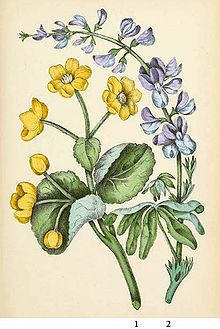- Lupinus perennis
-
"Old maid's bonnets" redirects here. For other uses, see Old Maid (disambiguation).
Lupinus perennis Young Perennial Lupin (Lupinus perennis) Scientific classification Kingdom: Plantae (unranked): Angiosperms (unranked): Eudicots (unranked): Rosids Order: Fabales Family: Fabaceae Subfamily: Faboideae Genus: Lupinus Subgenus: Platycarpos Species: L. perennis Binomial name Lupinus perennis
L.Lupinus perennis (also Indian beet, Old maid's bonnets, Blue Lupine, and Sundial lupine) is a medicinal plant in the Fabaceae family. It is widespread in the eastern part of the USA (from Florida to Maine), Canada (south of Ontario), and on the coasts of the Arctic Ocean, where it grows on sand hills.
It derives only rosette-like radial leaves in the first year of vegetation. Stalks are numerous, erect, striated, slightly pubescent. Leaflets are obovate, with a blunted apex or pointed spear, naked from above, sparsely pubescent from below; their number is 7-11. Petioles are longer than leaflets; stipules are very small, almost missing.
The inflorescence is long, sparsely flowered, sometimes almost verticilate. Flowers can range from blue to pink, but are most often blue or bluish purple. The calyx is silky, without bractlets; its upper labium with a protuberant basis, is integral or weakly emarginate, the lower one is integral, almost twice longer than upper. Floral bracts are styliform, shorter than the calyx, early falling. The corolla is purple or white, three times longer than the calyx. The vexillum is shorter than the wings. The carina is weakly ciliate. Pods are yellow-grayish-brown, with straight lines, necklace-shaped, short and closely hirsute, easy shattered, with 5-6 seeds. Seed is oval with a light hilum.
The Sundial Lupin is used as foodplants by the caterpillars of several lepidoptera. Among these are the Frosted Elfin (Callophrys irus) and the rare and endangered Karner Blue (Lycaeides melissa samuelis), whose caterpillars feed only on Sundial Lupine leaves. Leaves that have been fed on by Karners have distinctive transparent areas where the larvae have selectively eaten only the green, fleshy parts.
Sundial lupine has been declining in number and range since the Industrial Revolution. It is estimated that it has declined in number by about 90% since 1900. This decline has been deemed one of the primary causes of the Karner Blues' endangerment. The main causes of its decline are thought to be habitat loss, habitat fragmentation, and poor management. Currently it is threatened in Iowa, Maryland and New Hampshire; it is endangered in Vermont and may be extirpated in Maine. Human development has eliminated a large portion of its viable habitat. Remaining habitat is often fragmented, which is problematic for the lupine because it limits the range over which it can reproduce. Viable sundial lupine habitat is often difficult to maintain because it flourishes after fires and other forms of disturbance. One reason this occurs is that sundial lupine seed coats are so tough that only pressure changes due to rapid heating or abrasion are strong enough to allow water to penetrate and start germination. Moreover, fires, feeding by large ungulates, and mowing can improve habitat quality for established lupines by changing soil quality, vegetative structure, leaf litter depth. The exact mechanism for this is currently being investigated. Overall, the primary issue is that not enough habitat is burned or otherwise disturbed frequently enough to support the plant.
External links
- "Lupinus perennis". Integrated Taxonomic Information System. http://www.itis.gov/servlet/SingleRpt/SingleRpt?search_topic=TSN&search_value=26091.
- Plants For A Future: Lupinus perennis
- USDA Plants Profile: Lupinus perennis
- Lupins: geography, classification, genetic resources and breeding
This Lupinus-related article is a stub. You can help Wikipedia by expanding it.


